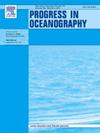赤道印度洋中东部地表下叶绿素最大值和缺氧水体季节性和形成的控制机制
IF 3.6
3区 地球科学
Q1 OCEANOGRAPHY
引用次数: 0
摘要
利用部署在赤道印度洋中东部(EEIO)的11个自主生物地球化学(BGC) Argo剖面浮标2029个剖面的温度、盐度、叶绿素-a (chl-a)、700 nm背向散射(bbp)和溶解氧(DO)的时间序列观测数据,研究了chl-a和DO在整个水柱上的季节变化,并确定了其变化的控制机制。EEIO全年都处于地表贫营养状态,除了夏季风期间,地表叶绿素浓度较弱(~ 0.65 mg m−3)时,地表下叶绿素最大值(SCM)较强(~ 0.8 mg m−3)。SCM是EEIO的一个持续特征,发生在60米左右。与chl-a相似,bbp浓度在混合层内较低,而最大值与SCM有关。采用海洋-生态系统耦合模型研究了SCM区域的硝化作用、浮游植物对硝酸盐(NO3)的吸收(摄取)以及维持NO3有效性的物理过程。我们发现,在生物过程中,吸收比硝化在SCM中占主导地位,因为硝化受到表面光的抑制,并且硝化最大值发生在SCM下方。NO3预算分析还表明,硝化最大值的垂直平流有利于SCM区域NO3的可用性。此外,DO的垂直分布在水深100-200 m之间的水柱上部200 m处呈现出狭窄的DO枯竭区,位于阿拉伯海高盐度水的下方,而在600-1200 m之间则呈现出更宽更深的DO枯竭区。受4°N的体积运输驱动,上部狭窄的do枯竭水从孟加拉湾向南延伸,在1 - 2月和8月达到最大范围。本文章由计算机程序翻译,如有差异,请以英文原文为准。
Mechanisms controlling the seasonality and formation of subsurface chlorophyll maximum and oxygen-depleted waters in the east-central equatorial Indian Ocean
The time-series observations of temperature, salinity, chlorophyll-a (chl-a), particle back scattering at 700 nm (b) and dissolved oxygen (DO) obtained from 2029 profiles of eleven autonomous biogeochemical (BGC) Argo profiling floats deployed in the east-central Equatorial Indian Ocean (EEIO) have been used to study the seasonal variability of chl-a and DO across the water column and to identify the mechanisms governing their variability. EEIO experiences surface oligotrophic condition throughout the year and exhibit a strong ( 0.8 mg m−3) subsurface chlorophyll maximum (SCM) except during summer monsoon when chl-a concentration at SCM is weak ( 0.65 mg m−3). The SCM is a persistent feature of the EEIO occurring at around 60 m. Similar to chl-a, the concentration of b is low within the mixed layer, while maximum values are associated with the SCM. A coupled ocean-ecosystem model was employed to investigate nitrification, the uptake of nitrate (NO) by phytoplankton (uptake), and the physical processes that maintain the availability of NO in the SCM region. We find that, among the biological processes, uptake dominates over nitrification in the SCM, as nitrification is inhibited by surface light, and the nitrification maximum occurs just below the SCM. The NO budget analysis also revealed that vertical advection from the nitrification maximum facilitates the availability of NO in the SCM region. Further, the vertical distribution of DO shows a narrow DO-depleted region in the upper 200 m of the water column between the depth of 100–200 m, which lies just below the Arabian Sea High Salinity Water and another wider and deep DO-depleted region between the 600–1200 m depth. The upper narrow DO-depleted water, driven by volume transport across 4°N, extends southward from the Bay of Bengal, reaching its maximum extent during January–February and August.
求助全文
通过发布文献求助,成功后即可免费获取论文全文。
去求助
来源期刊

Progress in Oceanography
地学-海洋学
CiteScore
7.20
自引率
4.90%
发文量
138
审稿时长
3 months
期刊介绍:
Progress in Oceanography publishes the longer, more comprehensive papers that most oceanographers feel are necessary, on occasion, to do justice to their work. Contributions are generally either a review of an aspect of oceanography or a treatise on an expanding oceanographic subject. The articles cover the entire spectrum of disciplines within the science of oceanography. Occasionally volumes are devoted to collections of papers and conference proceedings of exceptional interest. Essential reading for all oceanographers.
 求助内容:
求助内容: 应助结果提醒方式:
应助结果提醒方式:


